Primary Documents - First British Report on the Battle of Jutland, 2 June 1916
 Reproduced below is the
first official British statement issued in the wake of the 31 May-1 June 1916
Battle of
Jutland - up to that point arguably the greatest naval battle in
history.
Reproduced below is the
first official British statement issued in the wake of the 31 May-1 June 1916
Battle of
Jutland - up to that point arguably the greatest naval battle in
history.
Although regarded by many as tactically a German victory - more damage was inflicted upon the British Grand Fleet than upon the German High Seas Fleet - strategically the victory belonged undeniably to the British. The German Kaiser, Wilhelm II, afraid of the dangers faced by his fleet, forbade them to engage the British in similar fashion for the remainder of the war.
Thus the German fleet remained in port while the British controlled to patrol freely, imposing an increasingly effective naval blockade upon Germany.
Click here to read the first official German report on the battle; click here to read German naval minister Eduard von Capelle's report; click here to read British Grand Fleet Commander-in-Chief Sir John Jellicoe's report; click here to read an account of the battle by a German sailor; click here to read a British memoir.
First Official British Statement on the Battle of Jutland, 31 May-2 June 1916
London, June 2, 1916
On the afternoon of Wednesday, the 31st of May, a naval engagement took place off the coast of Jutland.
The British ships on which the brunt of the fighting fell were the battle-cruiser fleet and some cruisers and light cruisers, supported by four fast battleships. Among these the losses were heavy.
The German battle fleet, aided by low visibility, avoided a prolonged action with our main forces. As soon as these appeared on the scene the enemy returned to port, though not before receiving severe damage from our battleships.
The battle-cruisers Queen Mary, Indefatigable, and Invincible, and the cruisers Defence and Black Prince were sunk.
The Warrior was disabled, and after being towed for some time had to be abandoned by her crew.
It is also known that the destroyers Tipperary, Turbulent, Fortune, Sparrowhawk, and Ardent were lost, and six others are not yet accounted for.
No British battleships or light cruisers were sunk.
The enemy's losses were serious. At least one battle cruiser was destroyed and one was severely damaged. One battleship is reported to have been sunk by our destroyers.
During the night attack two light cruisers were disabled and probably sunk.
The exact number of enemy destroyers disposed of during the action cannot be ascertained with any certainty, but must have been large.
Further Statement
Since the foregoing communication was issued a further report has been received from the Commander-in-Chief of the Grand Fleet stating that it has now been ascertained that our total losses in destroyers amount to eight boats in all.
The Commander-in-Chief also reports that it is now possible to form a closer estimate of the losses and the damage sustained by the enemy fleet.
One dreadnought battleship of the Kaiser class was blown up in an attack by British destroyers and another dreadnought battleship of the Kaiser class is believed to have been sunk by gunfire.
Of three German battle-cruisers, two of which are believed were the Derfflinger and the Luetzow, one was blown up, another was heavily engaged by our battle fleet and was seen to be disabled and stopping, and the third was observed to be seriously damaged.
One German light cruiser and six German destroyers were stunk, and at least two more German light cruisers were seen to be disabled. Further repeated hits were observed on three other German battleships that were engaged.
Finally, a German submarine was rammed and sunk.
Source: Source Records of the Great War, Vol. IV, ed. Charles F. Horne, National Alumni 1923
'minnie' was a term used to describe the German trench mortar minnenwerfer (another such term was Moaning Minnie).
- Did you know?
